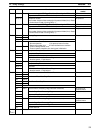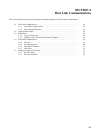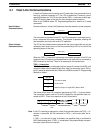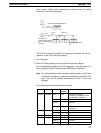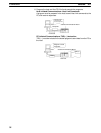
4-1SectionConnections
34
4-1 Host Link Communications
A Host Link System can be used to send C-mode Host Link commands from a
host (e.g., personal computer or PT) to a PC to read/write I/O memory, control
operating modes, etc. The PC can also use the TXD(––) instruction to send spe-
cified I/O memory data to the host for slave-initiated communications.
Refer to the CQM1H-series PC Programming Manual for details on C-mode
commands.
Communications in a Host Link System are normally started by a host computer.
Host computer
CQM1H-series PC
Command
Response
The host sends a command to the PC. The PC processes the command and re-
turns a response to the host computer. This process is repeated, allowing the
host computer to monitor and control PC operation.
The PC can also initiate communications with the host to send data, as may be
necessary when errors occur on the line controlled by the PC or to confirm the
operating status of the host.
Host computer
CQM1H-series PC
ASCII data
When the TXD(––) instruction is executed in the ladder program of the PC, the
contents of the I/O memory words specified for the instruction is converted to
ASCII and sent to the host. There is no response to this transmission.
TXD(––) Instruction
TXD(48) reads N bytes of data beginning from words S, converts it to ASCII, and
outputs the data from the specified port as a Host Link command. Up to 122 by-
tes (61 words) of data can be sent. Refer to the CQM1H-series PC Programming
Manual for details.
TXD(48)
S
C
N
First source word
Control word
Number of bytes: 4 digits BCD, 0000 to 0061
The format of the Host Link command generated by TXD(––) is shown below.
The command header code is EX and is followed by the specified data con-
verted to ASCII. There is no response to the EX command.
@ EX
x 10
0
x 10
1
↵
:
Node No. Header
code
122 characters max. TerminatorFCS
Send data (ASCII)
Note If the PC is sending a response to a Host Link command when the TXD(––) in-
struction is executed, the EX command for TXD(––) will be sent after the re-
sponse.
If TXD(––) is executed in Host Link Mode, the specified data is converted to
ASCII before being sent. If TXD(––) is executed in No-protocol Mode, the speci-
fied data is sent without conversion.
Host-initiated
Communications
Slave-initiated
Communications








